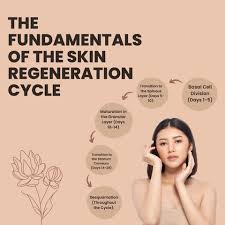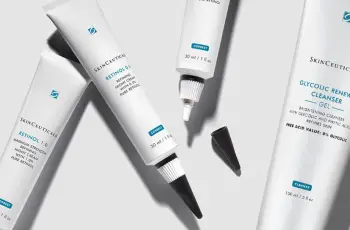
Exfoliation vs. Desquamation: Understanding How Your Skin Renews Itself
We all want healthy, glowing skin—but what really gives our skin that smooth, fresh appearance? The answer lies in two key processes: desquamation and exfoliation.
These two terms are often used interchangeably, but they are not the same. Understanding how they differ helps you make smarter choices in your skincare routine.
Let’s explore what desquamation and exfoliation are, how they work, and why they’re both crucial for skin health.
What Is Desquamation?
Desquamation is a natural, internal process where your skin sheds old, dead cells from its outermost layer.
The word “desquamation” comes from the Latin word squama, which means “scale,” like the scales on a fish. When cells fall off your skin in thin flakes, that’s desquamation.
This process happens in the stratum corneum, which is the top layer of the skin. It’s made up of dead, keratin-filled cells that protect the skin from damage.
Desquamation is essential. Without it, your skin would become dull, rough, and congested with layers of old cells.
What Is Exfoliation?
Exfoliation is a manual or chemical process where you actively remove dead skin cells from your skin using products or tools.
While desquamation is passive and natural, exfoliation is an external aid that speeds up the skin’s renewal process.
Exfoliation can be done using scrubs, brushes, enzymes, or acids like alpha hydroxy acids (AHAs) and beta hydroxy acids (BHAs).
These exfoliants break the bonds between skin cells and help slough them off faster, giving your skin a smoother, brighter appearance.
Desquamation vs. Exfoliation: The Key Difference
Both desquamation and exfoliation lead to the same result: the removal of dead skin cells.
The key difference lies in how the cells are removed:
Desquamation is a natural biological process.
Exfoliation is an intentional act, using tools or ingredients.
In a healthy skin cycle, desquamation happens on its own. But exfoliation can assist when this natural cycle slows down due to aging or dryness.
Why Does Desquamation Matter?
Desquamation is part of your skin’s keratinization cycle—the process by which new cells are formed, mature, and move to the surface.
This cycle begins in the basal layer of the epidermis, where stem cells divide and create keratinocytes.
These keratinocytes move upward through the skin’s layers. As they do, they begin to fill with keratin, a tough, protective protein.
By the time they reach the surface, they’re flat, dry, and no longer alive. Then they’re shed through desquamation.
The Role of Keratinization
Keratinization is the journey of a skin cell from birth to death. It typically takes about 28 to 40 days, depending on your age and skin type.
In the basal layer, stem cells give rise to new keratinocytes.
These cells move upward, forming the spinous and granular layers.
As they travel, they lose their nuclei and become flat, keratin-filled scales.
They arrive at the stratum corneum, the outermost layer, where they eventually flake off through desquamation.
Desquamation signals the end of this cycle and allows new, fresh skin cells to emerge.
What Happens When Desquamation Fails?
If your skin doesn’t shed properly, old skin cells can accumulate. This causes dullness, rough texture, and even clogged pores.
Inadequate desquamation can lead to conditions like:
Acne, Flaky patches, Ashy skin, Keratosis pilaris
Dehydrated or mature skin often has a slower desquamation rate. That’s when exfoliation becomes helpful.
How Exfoliation Helps the Skin
When natural desquamation slows down, exfoliants can help remove built-up dead skin.
This allows your moisturizers and serums to penetrate more effectively and promotes a brighter, clearer complexion.
There are two main types of exfoliation:
1. Physical Exfoliation
This includes scrubs, brushes, sponges, and cleansing tools that manually slough off dead skin. Be gentle—harsh scrubs can cause microtears.
2. Chemical Exfoliation
This uses acids or enzymes to dissolve the bonds between cells in the stratum corneum. AHAs (like glycolic acid) and BHAs (like salicylic acid) are popular examples.
Where in the Skin Do These Processes Happen?
Both desquamation and exfoliation affect the stratum corneum, the outermost layer of your skin.
This layer is composed of about 15 to 20 layers of flattened, dead keratinocytes held together by natural lipids.
Beneath this layer lies the epidermis, where keratinization occurs. The stratum corneum acts as a barrier and is key to both processes.
When you exfoliate or when desquamation naturally occurs, you are removing cells only from this top layer—not deeper.
Why Skin Type Matters
Different skin types have different needs when it comes to exfoliation.
Oily skin may need more frequent exfoliation to prevent clogged pores.
Dry or sensitive skin requires gentle exfoliation to avoid damage.
Mature skin benefits from chemical exfoliation to encourage cell turnover.
If you’re unsure which approach works best for you, it’s important to know your skin type. Over-exfoliating the wrong skin type can do more harm than good.
The Link Between Dehydration and Desquamation
Hydrated skin sheds more efficiently. When the skin lacks water, desquamation slows down, and cells stick together.
This leads to a buildup of flaky, uneven texture.
Overusing exfoliants can also dehydrate the skin, which ironically slows desquamation and leads to inflammation or breakouts.
That’s why you need a balanced routine: exfoliate wisely and always follow with hydration.
The Right Way to Exfoliate
To avoid irritation, choose exfoliants that suit your skin’s needs and sensitivity level. Here are a few tips:
Exfoliate 1–3 times per week, depending on your skin type
Use hydrating serums after exfoliating to nourish the skin
Avoid exfoliating after retinoid use or sunburn
Always follow with broad-spectrum SPF, especially when using acids
A Word on Skin Health and Skincare Products
Many skincare products are designed to assist with exfoliation or to support the natural desquamation process.
Look for ingredients like:
Lactic acid (hydrating and exfoliating)
Salicylic acid (great for oily or acne-prone skin)
Papaya or pumpkin enzymes (gentle for sensitive skin)
Retinoids (speed up cell turnover over time)
Using the wrong products or exfoliating too often can disrupt your skin barrier and damage your skin.
It’s important to choose exfoliants based on your Baumann Skin Type or another reliable skin typing system.
Summary: Exfoliation vs. Desquamation
Process How It Happens Voluntary or Natural Role in Skincare
Desquamation Enzymes break cell bonds Natural Maintains healthy skin shedding
Exfoliation Physical/chemical exfoliants External action Boosts turnover and smoothness
Both play vital roles in skin health. Exfoliation is not a replacement for desquamation but a tool to support it.
Understanding the difference helps you maintain smoother, clearer, and more radiant skin.
Final Thoughts
Desquamation is your skin’s built-in renewal process. It’s natural, ongoing, and essential for healthy skin function.
Exfoliation is the way we support this process with skincare products—when needed.
But overdoing it or using the wrong method can damage the skin’s barrier, slow healing, and cause irritation.
Stick with a skincare routine that supports your natural skin cycles. Hydration, sun protection, and gentle exfoliation will help your skin stay vibrant.
Want to know the best exfoliator for your skin? Take a trusted skin type quiz or talk to a dermatologist to guide your choices.
Healthy skin isn’t about doing more—it’s about doing what’s right for your skin.


